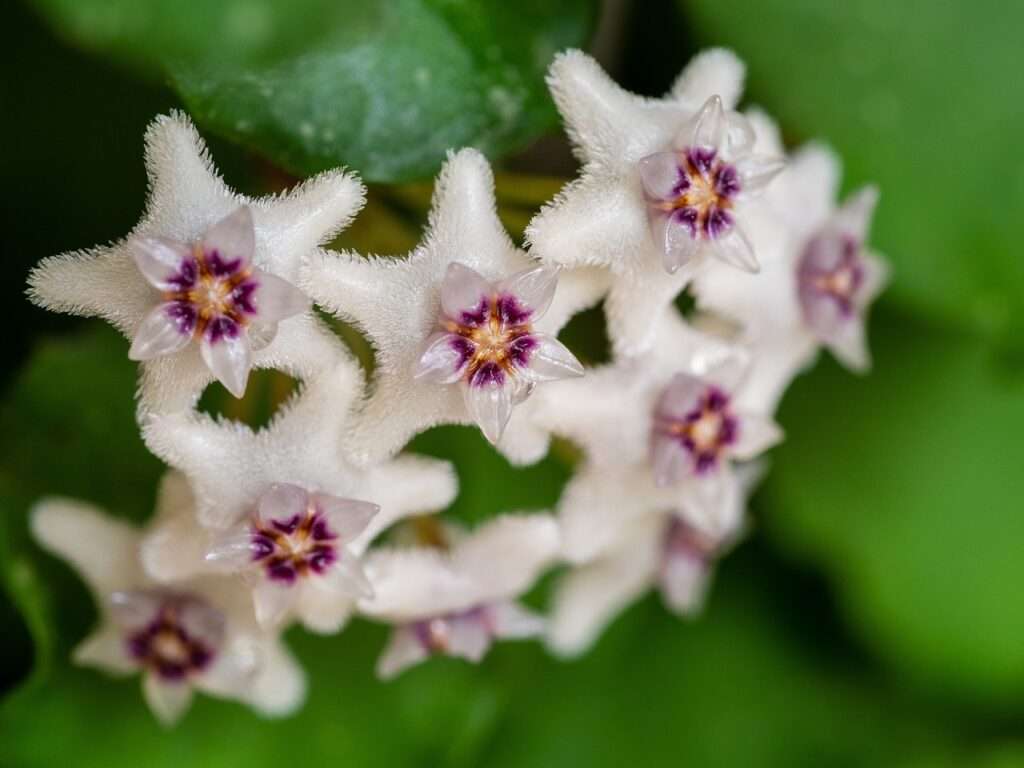Within the large kingdom of plants, many wonderful species can inspire people; one such plant is the Hoya black margin flower. Both professionals in the plant category and regular garden lovers adore this splendid plant with its distinctive look and highly interesting features. The Hoya black margin flower is not just a cosmetic beauty in the calendar of flowering plants; it is nature’s creation and survivalist at its best. Subsequently, in this article, we will strive to uncover all aspects of this extraordinary plant, backing to its roots and necessity, and analyze the processes that have led to its increased popularity.

Origins and Natural Habitat
The hoya parasitica black margin flower, together with many of the Hoya flowers, originates from the tropical forests of Southeast Asia. Some of these plants have grown to outweigh their environments in Thailand, Indonesia, and the Philippines because of their warm and artificial humidity. In its element, Hoya black margin flowers can grow on trees as epiphytes or lithophytes clinging to rocks.
The context in which the Hoya black margin flower has adapted is its particular features, so it is a very unpretentious flower that can be grown in different conditions and climates if it receives proper care. That is why the Hoya black margin flower has become a favorite of many home growers of indoor plants worldwide.
Characteristics of the Hoya Black Margin Flower
The main difference between the Hoya black margin flower and the other species of Hoya plants is their leaf rim, which is black. This dark outline makes the plant stand out, with the foliage being green or speckled to give the plant a beautiful look, like a painting. The foliage of this Hoya black margin flower tends to be thick and glossy; this is due to the nature of the plant’s habitat in the tropics, where moisture around the leaves is expected.
But like what has been said, the beauty in the Hoya black margin flower does not just come from its leaves. However, this plant blooms to give clusters of small star-like flowers that deserve admiration. These flowers are typically pink, white, or cream and are surrounded by a centrally placed corona that may vary from deep red to almost black, which is a boon to the plant’s glamour quotient.
The flowers of the Hoya black margin flower are greatly stunning, and, in addition to that, these flowers also give off quite a pleasant, sweet scent, especially at night. This scent is believed to have been developed to be used at night due to possible early evolution for pollination from pollinators that fly at night.

Hoya Black Margin care
General care of a Hoya black margin flower is a good pursuit for any hobby grower, irrespective of whether one is new to the practice or already an experienced grower. It is worth noting, however, that all these plants are easy to manage, and if one is to pay close attention, there is no way these plants cannot blossom in the grasp of the ‘gardener.’
1. Light Requirements:
The Hoya black margin flower should be grown in bright, indirect light. Although catnip can handle some direct sunlight, especially in the morning or evening, it can get scorched by direct, intense light. As for the Hoya black margin flower, a spot close to an east or west window is usually the best indoors.
2. Watering Needs:
The Hoya black margin flower requires a consistently moist environment but should not be overwatered as this will cause root rot, a common problem in tropical plants. The plant’s soil should be allowed to dry partially, where the upper layer of an inch or two should be dry before it is watered again. Watering may be needed more often during the spring and summer periods, while less in the fall and winter because the plant is not growing as it is during the spring and summer.
3. Humidity and temperature:
The Hoya black margin flower originated from tropical areas; the plant relishes in high humidity. If your home environment is dry, then it is advisable to place a humidifier or a tray with pebbles and water next to the plant. Concerning temperature, the Hoya black margin flower is well suited to warm climates, that is, 60°F–80°F (15°C–27°C).
4. Soil and fertilizer:
The Hoya black margin flower requires well-draining soil, and the potting mix should be of this nature. Using a combination of typical garden soil, orchid bark, and perlite in equal proportions will enable one to prepare the perfect soil composition that holds moisture while still draining at the same time. Fertilize your Hoya black margin flower with a balanced, water-soluble fertilizer once every 2–4 weeks during the growing season.
5. How do you make a Hoya bloom
Another beautiful thing I found in the Hoya black margin flower again is that it is quite easy to propagate. It is very easy to get stem cuttings to root; you only need to use water or any favorable medium of your choice to plant. This characteristic makes the Hoya black margin flower versatile enough to be added to one’s collection or gifted to friends and loved ones.
As for the growth habits of the Hoya black margin flower, they are characteristic of the trailing or climbing type. If in its natural environment, it would utilize the aerial roots to cling to trees or rocks. In home environments, if a trellis is given or the plant is grown in a hanging basket, its appearance can be stunning due to its vine-like appearance.
It is also necessary to realize that while we concentrated on describing the Hoya black margin flower specifically, Hoyas play an essential cultural role in many Southeast Asian countries. To some extent, these plant species are regarded as symbols of good luck and prosperity for the family. In these sentiments, the Hoya black margin flower, which has an outstanding aesthetic, is usually given priority.
However, strength and flexibility are seen in some of the flowers, like the Hoya black margin flower, making the plant associated with strength, especially among some cultures. Generations of plant lovers adore them since they are moisture-loving plants, and they are very long-lived.

Challenges and Common Issues
Thus, the Hoya black margin flower is relatively resilient; however, it is not without its issues, more so if grown in other environments than its native state. Another problem is a loss of leaves, often due to an abrupt shift in weather and the degree of light. Another issue could be overwatering because this causes root rot—a condition that is deadly to the plant if not handled early enough.
This beautiful Hoya black margin flower may be bothered by pests like mealybugs and other spider mites once in a while. Prevention is the key to managing these pests. A routine check will also reduce the number of these pests, and insecticidal soap or neem oil should be used should one be spotted; it should be done immediately.
Besides this, there is another problem that Hoya black margin flower fans deal with, and it is to force the plant to bloom. The foliage is rather nice, but the flowers stand out in this plant. Light, humidity, and nutrients are essential factors that need to be balanced during the blooming of the Hoya black margin flower.
Conclusion
This flower, Hoya black margin, is a perfect testament to how diverse and beautiful the plant kingdom can be. They have a rather impressive appearance and do not demand very complex conditions for their maintenance, making them valued indoor garden decorations. Be it the margined leaves through which it thrives, the clusters of fragrant flowers that this plant displays, or the simple satisfaction of growing the Hoya black margin flower being a touch of tropical in one’s household.
While moving forward to increase our affection towards different plants like the Hoya black margin flower, we are also enabling our environment and home with natural aesthetics and building a strong relationship with our mother nature’s diversities. The process is enriching, making us our best in many ways, as we tend to the beautiful Hoya black margin flower vital to our aroma house.
Thus, if you are already attending to hoyas or are interested in houseplants for the first time, it would be worth bringing the wonders of the Hoya black margin flower into your life. This peculiar green companion has a certain charm and, at the same time, is quite humane and lenient to the owner’s mistakes, which will make it a favorite plant in no time.
FAQS
Q. My Hoya black margin flower has yellowing leaves; why is this?
The shape of the leaves: if leaves assume a yellow color, the likely causes are that you may be watering your plant too much or too little, or the plant lacks adequate nutrients. First, you should look into your watering frequency; if the issue continues, you may want to feed your plant or report it.
Q. Are the flowers of Hoya black margin better off being rootbound?
Like most Hoyas, the black margin variety does not mind being slightly root-bound. However, at times, it can even trigger blossoming. However, if this happens and roots start coming out of the drainage holes, it is time to transfer the plant to a new pot.


